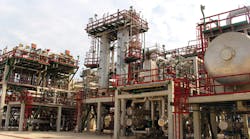US refineries and petrochemical plants reported fewer injuries and illnesses in 2004 than in past years, according to a recent report from the National Petrochemical & Refiners Association.
Released in late March, NPRA’s annual “Survey of Occupational Injuries and Illnesses” reported that 36 member facilities worked a full year without a recordable incident, up from 27 facilities in 2003.
The report includes safety data from 246 facilities-119 refineries and 127 petrochemical plants; an increase from the 238 facilities reporting in 2003. Additionally, 138 NPRA facilities recorded no lost workday incidents in 2004.
The format of the report is consistent with the US Occupational Safety & Health Administration’s recordkeeping rule (29 CFR 1904), which went into effect on Jan. 1, 2002.
NPRA reported data-standardized to 100 full-time employees and based on an entire calendar year-for:
- Total recordable incidence rate (TRIR), which is the total number of recordable cases.
- Days away, restricted, or transferred (DART) rate. Before 2002, this was reported as fatalities and lost workday cases rate.
- Day count rate, which includes the total number of days away from work and the total number of days of job transfer or restriction.
- Fatality and days away from work (DAW) case rate.
Refineries
In 2004, the TRIR for US refineries was 1.16 cases/100 full-time employees, down from a rate of 1.5 cases/100 full-time employees in 2003. The TRIR was as high as 3.0 cases/100 full-time employees in 1996.
The fatality and DAW case rate in 2004 was 0.26 cases/100 full-time employees, a decrease from about 0.4 cases/100 full-time employees in 2003. This measurement was 0.6 cases/100 full-time employees as recently as 1999.
The DART rate for US refineries in 2004 was 0.61 cases/100 full-time employees, down from 0.8 cases/100 full-time employees in 2003. The DART has decreased from 1.5 cases/100 full-time employees in 1996.
The day count rate was 31.8 cases/100 full-time employees in 2004, a decrease from 39.4 cases/100 full-time employees in 2003. In 1996, this rate was 61.1 cases/100 full-time employees.
Petrochemical plants
In 2004, the TRIR for US petrochemical plants was 0.95 cases/100 full-time employees, down from 1.2 cases/100 full-time employees in 2003. In 1995, the TRIR was 2.2 cases/100 full-time employees for US petrochemical plants.
The fatality and DAW case rate in 2004 was 0.23 cases/100 full-time employees, a decrease from about 0.3 cases/100 full-time employees in 2003. This measurement was 0.4 cases/100 full-time employees as recently as 2000.
The DART rate for US petrochemical plants in 2004 was 0.48 cases/100 full-time employees, down from 0.6 cases/100 full-time employees in 2003. The DART has decreased from 1.1 cases/100 full-time employees in 1995.
The day count rate was 26.38 cases/100 full-time employees in 2004, a decrease from 30.9 cases/100 full-time employees in 2003. In year 2000, this rate was 35.8 cases/100 full-time employees.
